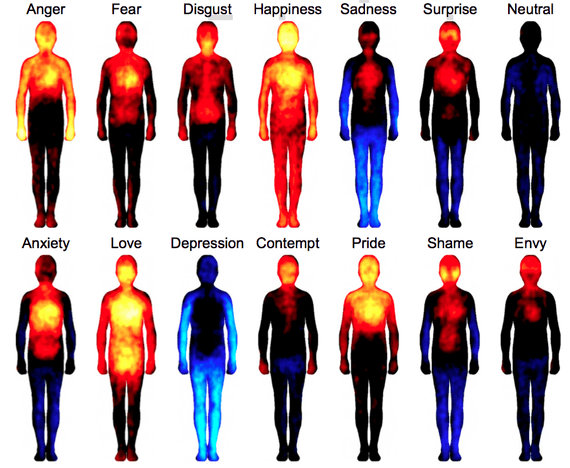Finnish researchers have uncovered a very interesting correlation between our bodily sensations and emotional responses. In a study recently published in Proceedings of the National Academies of Sciences, 733 participants from Taiwan, Finland and Sweden took part in five experiments to indicate how certain emotionally charged words, stories, movies or facial expressions made them feel within their body. Each participant was asked to highlight where within their body they felt a reaction. Bodily regions were colored within blank silhouettes to indicate the level of activity in response to each stimulus.
This study by Aalto University researchers has created a wonderful graphical representation of what happens in our body in response to emotional imagery, showing how happiness and depression manifest within our physiology. You can see when you literally ‘light up with joy’ at the sight of a loved one or completely collapse under the weight of depression.
I often ask my students or clients to describe what stress feels like in their body. “Anxious,” “hopeless,” and “fearful” are common responses. Unfortunately, these are emotional terms that do not really tell us much about what is happening in our body. So, I have to ask them to describe what anxiety/hopelessness/fear feels like in their body. Usually, there is a moment of silence and an awkward pause as they scratch their head and search for an answer.
For a variety of reasons, we here in the West are deeply disconnected from our bodies. We struggle to articulate what happens to our physiology when we are deeply happy or profoundly sad. We don’t know what happens to our heart rate or breathing when we are angry. We don’t know where we hold tension in our bodies or if we clench our jaw during difficult conversations. We may have a brief glimpse of our response, but we really do not give it much thought.
The majority of my work as a somatic educator is to help build self-awareness within my clients and students. Without awareness, it is impossible to change behavior or develop skill. You can read every book ever written and take every training on the market, but you will still be hopelessly lost if you do not understand who you are and what you can and cannot do.
Once you are better able to perceive what is happening within your body, you will become more emotionally intelligent. If you can identify how changes in your body directly relate to changes in emotion, you can begin to make different choices. Instead of impulsively reacting, you can use this self-awareness to make a different choice. Every time your eyes narrow and your fists clench, you’ll know an angry outburst is about to follow. But you will now have the opportunity to choose differently.
This opportunity for choice is central to high-performing teams, outstanding leadership and quality conflict resolution. So the next time you start to lose your temper, take a look at these images and see if you can start to choose differently.

